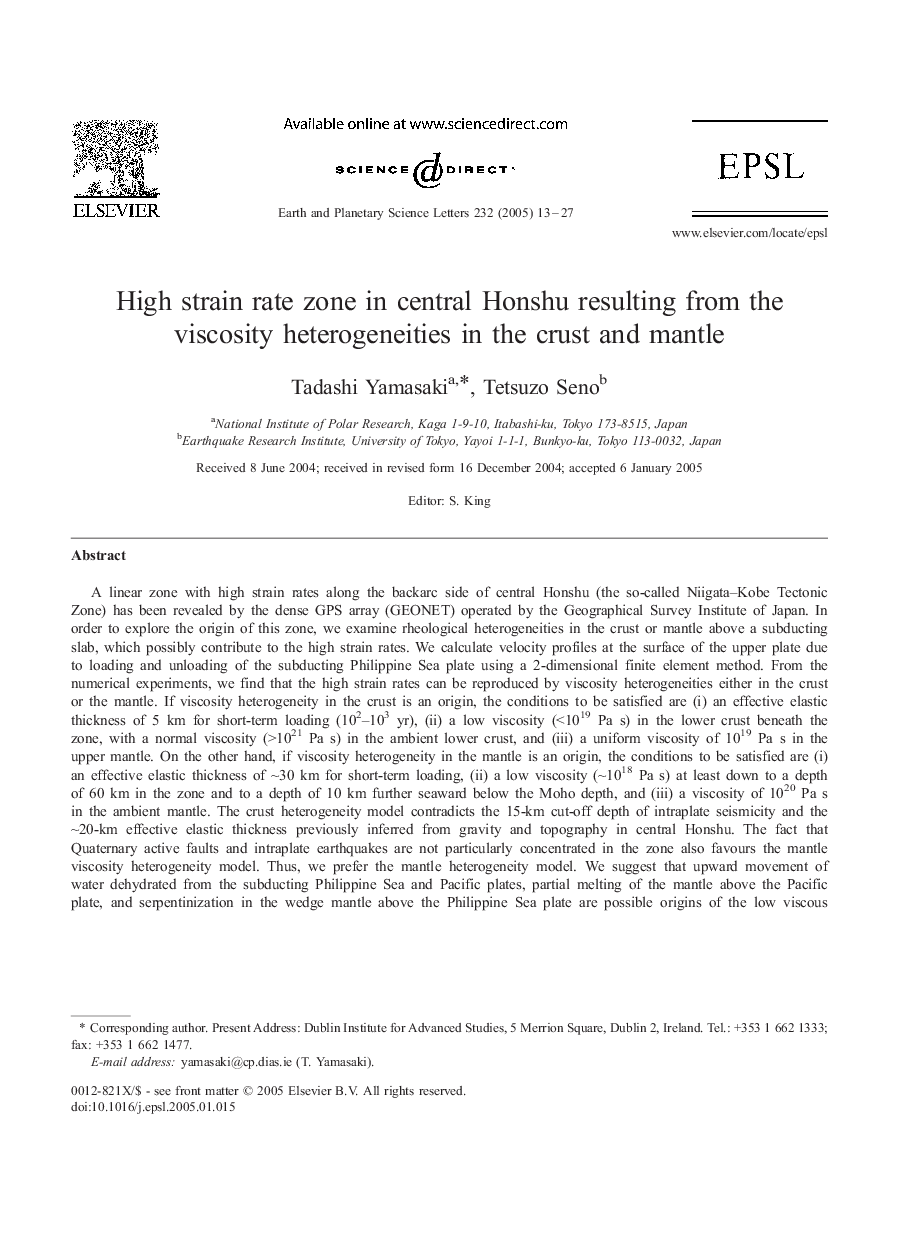| کد مقاله | کد نشریه | سال انتشار | مقاله انگلیسی | نسخه تمام متن |
|---|---|---|---|---|
| 9522704 | 1634970 | 2005 | 15 صفحه PDF | دانلود رایگان |
عنوان انگلیسی مقاله ISI
High strain rate zone in central Honshu resulting from the viscosity heterogeneities in the crust and mantle
دانلود مقاله + سفارش ترجمه
دانلود مقاله ISI انگلیسی
رایگان برای ایرانیان
کلمات کلیدی
موضوعات مرتبط
مهندسی و علوم پایه
علوم زمین و سیارات
علوم زمین و سیاره ای (عمومی)
پیش نمایش صفحه اول مقاله

چکیده انگلیسی
A linear zone with high strain rates along the backarc side of central Honshu (the so-called Niigata-Kobe Tectonic Zone) has been revealed by the dense GPS array (GEONET) operated by the Geographical Survey Institute of Japan. In order to explore the origin of this zone, we examine rheological heterogeneities in the crust or mantle above a subducting slab, which possibly contribute to the high strain rates. We calculate velocity profiles at the surface of the upper plate due to loading and unloading of the subducting Philippine Sea plate using a 2-dimensional finite element method. From the numerical experiments, we find that the high strain rates can be reproduced by viscosity heterogeneities either in the crust or the mantle. If viscosity heterogeneity in the crust is an origin, the conditions to be satisfied are (i) an effective elastic thickness of 5 km for short-term loading (102-103 yr), (ii) a low viscosity (<1019 Pa s) in the lower crust beneath the zone, with a normal viscosity (>1021 Pa s) in the ambient lower crust, and (iii) a uniform viscosity of 1019 Pa s in the upper mantle. On the other hand, if viscosity heterogeneity in the mantle is an origin, the conditions to be satisfied are (i) an effective elastic thickness of â¼30 km for short-term loading, (ii) a low viscosity (â¼1018 Pa s) at least down to a depth of 60 km in the zone and to a depth of 10 km further seaward below the Moho depth, and (iii) a viscosity of 1020 Pa s in the ambient mantle. The crust heterogeneity model contradicts the 15-km cut-off depth of intraplate seismicity and the â¼20-km effective elastic thickness previously inferred from gravity and topography in central Honshu. The fact that Quaternary active faults and intraplate earthquakes are not particularly concentrated in the zone also favours the mantle viscosity heterogeneity model. Thus, we prefer the mantle heterogeneity model. We suggest that upward movement of water dehydrated from the subducting Philippine Sea and Pacific plates, partial melting of the mantle above the Pacific plate, and serpentinization in the wedge mantle above the Philippine Sea plate are possible origins of the low viscous upper mantle. Possible low viscosities in the upper mantle wedge presented in this study seem to provide important constraints for subduction processes of oceanic plates and strain accumulation processes in the upper plate.
ناشر
Database: Elsevier - ScienceDirect (ساینس دایرکت)
Journal: Earth and Planetary Science Letters - Volume 232, Issues 1â2, 30 March 2005, Pages 13-27
Journal: Earth and Planetary Science Letters - Volume 232, Issues 1â2, 30 March 2005, Pages 13-27
نویسندگان
Tadashi Yamasaki, Tetsuzo Seno,